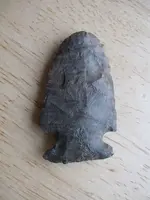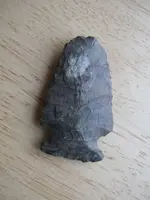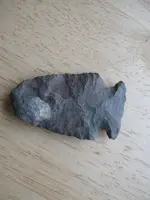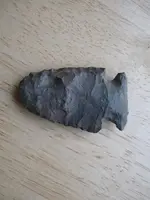creek astronaut said:
nice point nature girl.im sure matt is on point with the type.matt you did raise an interesting question or two.the first thing that i noticed about her point/scraper was the rounded tip and i kind of thought it was a hafted chisel or maybe even a spokeshave,you can see in the pic of the side that has the white splotch near the tip that it has a spokeshave look to it or was it damaged?im sure you know there is a diffference between a hafted scraper and a hafted chisel,but they sometimes get lumped together.i personally think this would be typed a hafted chisel.scrapers would only have one worked/use edge at a much more steep of an angle than this artifact imo.the other interesting question you brought up was whether hafted scrapers were made that way or were salvaged points.i cant say one way or the other.i find alot of hafted scrapers here in ohio and have always been very intrigued by them.what proof do you have to say that they were sometimes purpose made flint tools?
That's a very good question CA. For many years, like everyone else, I used to assume that they were only the result of salvaging points. Until one site changed my view.
Let me give you an idea of the site. The site itself is an incredible place, what many people dream of. Most of the sites we find are multi-component, where many different cultures and types are represented. However this site was inhabited by a single culture only, no mixing or blending. It gives the chance to study a certain people and tools they used, without having to postulate what went where. We call it "Hopehell", due to the Hopewell culture that inhabited it. It's not a terribly large site, located at the confluence of a very large creek and major river. The amount of artifacts there are staggering. On average, I would find between 30 and 40 complete, notched points (not including any tools or broken items) every time I am there. Almost all of these pieces are Snyders affinis: Snyders, Grand, Gibson, etc). However, we also did find a few representative stemmed Hopewell forms also (Waubesa / Dickson). Four different main types of un-hafted knives were recognized, including a few squared ones. There also were many Hopewell Picks found, which is typical for Ozark middle-Woodland Hopewell. These "picks" remind a person of a Kerrville knife down in TX. There is usually a crude end with the cortex left on it and then a long, slender distal end that resembles a crude hand-held drill. They are large, often attaining 6"-8" in length or more.
Two pipes and quite a bit of pottery was also recovered. While a few pieces were plainware, most of the pottery was of the highly decorate Cooper Zone Stamped style. It's a dream of mine to have a Hopewell "Zone Stamped" (Cooper, Havanna, I don't care), but I seriously doubt that will happen. They are more rare than hen's teeth, lol.
Several "Cottonrock" celts were found. They are named cottonrock, due to the weight and appearance. They are very light, almost reminding a person of talc. It's from a tripolitic weathering process, mainly from Reed Springs (in the Ozarks area at least). In fact, there are many tripoli mines in the region.
One thing that was amazing was the amount of hafted scrapers at the site, a very high percentage. Calling them all "scrapers" is often a generic term, as they could have been used for other purposes other than scraping hides alone. In fact, the majority were probably used as knives. The "chisel" end did not really seem to be a factor. The vast majority are knapped on one side alone, giving them a very steep edge. These adze-like tips are preferred in the scraping of hides, but also (as noted) would have made a very good knife edge for cutting. Use-wear analysis would have to be done to ascertain the exact use of each piece, although I can be fairly certain by the types of items found in association, they were used in the butchering and scraping process.
A very exciting find were two "hafted scrapers" that made me expand my point of view at the type. What made them so unique, is that they were both in the stages of manufacture as intentional rounded-point hafted scrapers / knives. They have never been resharpened, used, or even finished. Both of them had one notch each. They did not finish and put a notch on the other side because the material and faults prohibited that. Both were made from an oval preform. Out of probably 20,000 complete, notched Snyders Afinis points from Hopehell, these two were among my favorite. It has to do with the information I gained from them. Here is a crappy picture of one of them (It's a pic I had on file, I don't have images of both of them). Both are Grand style points. Even though it is an exception, it does show that at least some were intentionally made to the form.











